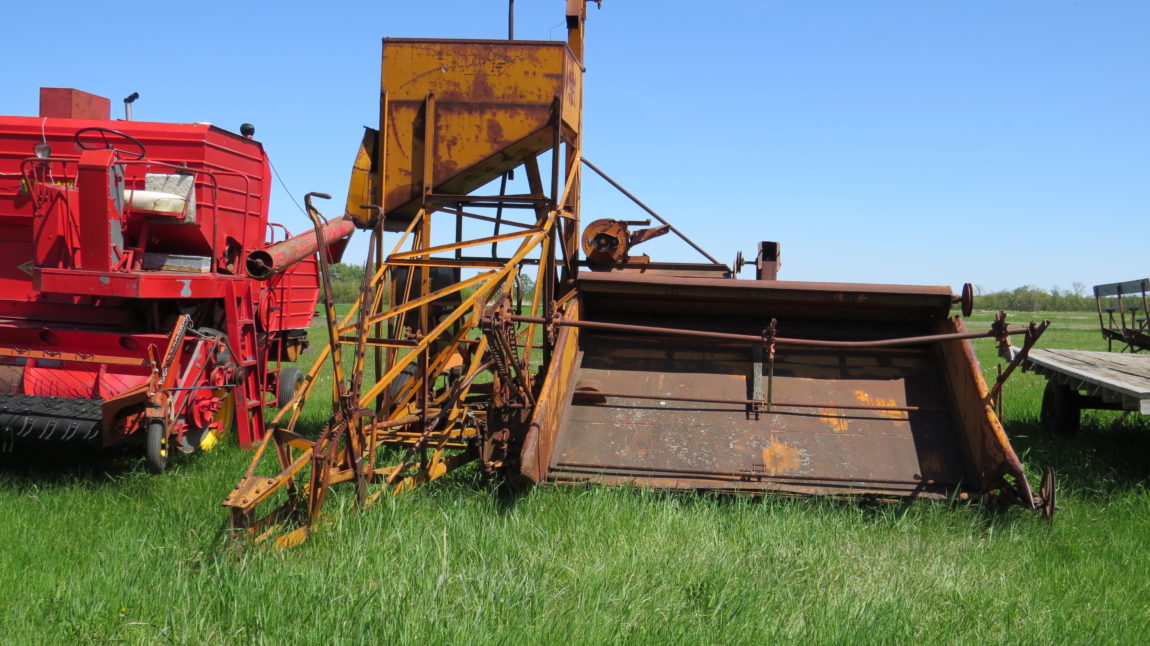Before Cockshutt built its well known self propelled combines, Cockshutt built a couple of pull type combines models. The Number 6 was in production in 1939 and 1940 and the Number 7 replaced the 6 in 1941.
The Number 7 featured a 38 inch cylinder with a 6 foot or 8 foot cutting table width. The machine was available either with power take off drive or an auxiliary engine drive. The auxiliary engine option featured a 4 cylinder Hercules IXB-3 gasoline engine. The grain tank held 35 bushels. A re-cleaner has been fitted to this machine.
Oddly for a pull type combine the table is on the right side of the machine. Standard practice was for a left hand side table.
The machine was put into production in 1941 to replace the Cockshutt Number 6 combine and may have remained in production until 1954 when the Cockshutt Model 422 pull type combine was introduced.

Canadian farm implement manufacturers continued to produce farm machinery and parts through the Second World World War but at a much reduced level of production. It was important for Canada to fill Britain’s need for food. To complicate matters, much farm labor had enlisted in Canada’s armed forces leading to farm labor shortages. So the Canadian government decided that steel, other materials and factory space had to be allocated to farm machinery production as this machinery was needed to replace the lost labor. The government allocated materials to specific types of machines on a complicated formula based on 1940 production, demand for farm products and the amount of labor saved by a particular machine. Overall production was set at about 25% of 1940 production of complete machines with parts production at 150% of 1940 production. The Cockshutt annual report for 1942 listed the shipment of 500 Number 7 combines in the fall of 1942.
The MAM collection includes a Cockshutt Number 7 pull type combine however this combine is painted in Co-op colors.
Cockshutt wanted to increase sales in 1945 which meant it had to get into the US market. Cockshutt and the US based National Farm Machinery Co-operative (NFMC) came to an agreement where Cockshutt implements were sold through NFMC outlets across 11 states. Frost and Wood, a subsidiary of Cockshutt which made haying and harvesting equipment .was also included in this deal. The deal with NFMC allowed Cockshutt into 11 states where Cockshutt had no previous presence and all at a low cost.
However to get the deal with NFMC, Cockshutt also had to agree to supply equipment to Canadian Co-operative Implements Limited (CCIL). Cockshutt was not in favor of supplying equipment to CCIL as CCIL would be in competition for sales of equipment with Cockshutt operations in Western Canada. However the NFMC was adamant that CCIL was to be included. The deciding factor was that both Co-ops agreed to take a large amount of equipment and would pay for this equipment in advance. As Cockshutt at the time was in the process of developing its own tractor line and expanding its combine line, this money was needed by Cockshutt and so Cockshutt agreed to supply NFMC and CCIL. Cockshutt painted the equipment supplied to both co-ops in each of the co-ops color schemes. The orange used by CCIL was different in shade from the orange used by NFMC.


